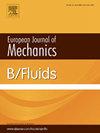The horizontal far wake behind a heated or cooled body
IF 2.5
3区 工程技术
Q2 MECHANICS
引用次数: 0
Abstract
Buoyancy affects the horizontal wake far downstream of a heated or cooled body in an indirect manner via the hydrostatic pressure perturbation. Plane flow at large Reynolds and Péclet numbers is considered in this paper. The buoyancy effects are characterized by a Richardson number. Both laminar and turbulent flows are investigated to provide asymptotic solutions that are suitable as outflow boundary conditions in computational fluid dynamics.
Similarity transformations, which are universal, lead to sets of ordinary differential equations. The interaction between the wake and the outer potential flow is taken into account by applying Bernoulli’s equation as a boundary condition. As the thermal energy equation and the boundary conditions for the temperature perturbation are homogeneous, the magnitude of the temperature perturbation is determined by the over-all thermal energy balance.
The results of the analysis are in remarkable contrast to the classical non-buoyant wake solutions. Driven by the hydrostatic pressure disturbance, the flow does not decay in streamwise direction. The flow is governed by the total heat flow at the body, whereas the effect of the drag force is negligible.
The set of ordinary differential equations is solved numerically. For laminar flow, two kinds of solutions are found for Richardson numbers below 0.734. One kind of solutions describes a flow field containing a reversed-flow region. For turbulent flow a turbulence model based on the turbulent kinetic energy balance is applied. In addition, the limit of weak buoyancy effects is considered, leading to power laws in terms of the Richardson number.
被加热或冷却的物体后面的水平远尾
浮力通过静水压力扰动间接影响加热或冷却物体下游的水平尾迹。本文考虑了大雷诺数和psamclet数下的平面流动。浮力效应用理查德森数表示。研究了层流和湍流两种流动,并给出了适合作为计算流体动力学中流出边界条件的渐近解。相似变换是普适性的,它可以得到一组常微分方程。采用伯努利方程作为边界条件,考虑了尾迹与外部势流之间的相互作用。由于热能量方程和温度扰动的边界条件是齐次的,因此温度扰动的大小取决于整体的热能量平衡。分析结果与经典的非浮力尾流解有明显的对比。在静水压力扰动的驱动下,水流不沿顺流方向衰减。流动是由在身体的总热流控制,而阻力的影响是可以忽略不计的。用数值方法求解了这组常微分方程。对于层流,理查德森数在0.734以下有两种解。一种解描述了包含逆流区域的流场。对于紊流,采用基于紊流动能平衡的紊流模型。此外,考虑了弱浮力效应的极限,得出了Richardson数的幂律。
本文章由计算机程序翻译,如有差异,请以英文原文为准。
求助全文
约1分钟内获得全文
求助全文
来源期刊
CiteScore
5.90
自引率
3.80%
发文量
127
审稿时长
58 days
期刊介绍:
The European Journal of Mechanics - B/Fluids publishes papers in all fields of fluid mechanics. Although investigations in well-established areas are within the scope of the journal, recent developments and innovative ideas are particularly welcome. Theoretical, computational and experimental papers are equally welcome. Mathematical methods, be they deterministic or stochastic, analytical or numerical, will be accepted provided they serve to clarify some identifiable problems in fluid mechanics, and provided the significance of results is explained. Similarly, experimental papers must add physical insight in to the understanding of fluid mechanics.

 求助内容:
求助内容: 应助结果提醒方式:
应助结果提醒方式:


